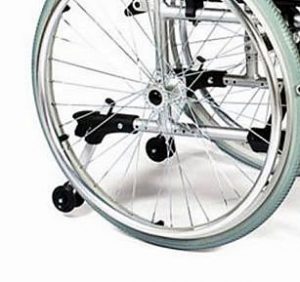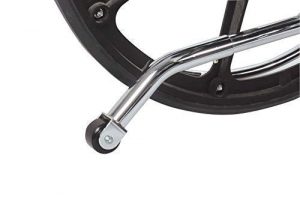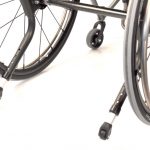Most wheelchairs are supplied with small wheels at the rear of the chair situated just above ground level. These wheels are sometimes referred to as safety wheels or occasionally anti tip bars. These wheels are generally very small with diameter of about 5cms to 8cms and typically have none marking rubber or nylon tyres.
 The sole purpose of these anti tip wheels is to prevent the wheelchair from becoming unstable by tipping backwards beyond a point where the centre of gravity becomes unstable. Causes of rearward tip of a wheelchair are generally as a result of too much power provided by the user of a self-propelled wheelchair or too much force being applied by the attendant or carer to lift the front of the chair to mount a kerb or single step.
The sole purpose of these anti tip wheels is to prevent the wheelchair from becoming unstable by tipping backwards beyond a point where the centre of gravity becomes unstable. Causes of rearward tip of a wheelchair are generally as a result of too much power provided by the user of a self-propelled wheelchair or too much force being applied by the attendant or carer to lift the front of the chair to mount a kerb or single step.
Understanding how a wheelchair responds to the user’s input is important where a self-propelled or manual wheelchair is in use. Effectively when the user applies too much downward force to the front of the large propelling wheels it creates an opposite fore that will cause the front of the wheelchair to become lifted. If there are no anti tip wheels in place, this can result in the chair going over backwards, potentially causing alarm and or injury to the user and the chair.
Wheelchair stability
Some wheelchairs have frame adjustment and the rear wheel setup can be moved to stabilise the centre of gravity making it very unlikely that the user can over tip the chair. The further forward the user is, the more of their weight is carried over the front wheels of the wheelchair. Not all chairs have this feature and when it cannot be adjusted a pair of anti-tip wheels is a good feature to look for.
Some wheelchair users are not in favour of the anti-tip wheels as they can cause one or two inconveniences. Firstly, they can hinder tipping of the wheelchair by the carer to mount high curbs. As the wheelchair lifts, by design, these anti tipper wheels come in to contact with the ground thus preventing the required angle to mount the curb stone or step. Similarly, when descending the kerb these wheels can also cause hinderance by grounding the wheelchair.
 Secondly, anti-tipper wheels can cause additional problems when the wheelchair is dismantled for storage or transportation. Because the wheels (or bars) extend towards the back of the chair, they effectively make the overall length of the frame larger.
Secondly, anti-tipper wheels can cause additional problems when the wheelchair is dismantled for storage or transportation. Because the wheels (or bars) extend towards the back of the chair, they effectively make the overall length of the frame larger.
Fixed or removeable anti tippers
Some anti-tipper wheels can be removed but this becomes a bit involved and is over complex when you simply want to transport the chair. Although some are designed to insert in to the stepper tubes making this operation fairly simple.
If a wheelchair user feels insecure in their chair due to its tendency to tip backwards then anti tipper wheels or bars are a great feature to have and provide peace of mind. Typically, younger users with more upper body strength and better coordination will often chose a model without anti tippers.
Some more energetic users prefer to manoeuvre their self-propelled wheelchair using movements that lift the front wheels. This is referred to as back wheel balance or BWB. This enables them to execute very accurate tight turns among other things. For this reason, they are confident in their chairs ability and would prefer not to have any form of anti-tip device fitted.
Other reasons some users prefer not to have anti tippers are the additional weight that they add. Although relatively lightweight, these wheels or bars will add some weight. Some folk also find that they prevent progress on rough terrain as they can cause the wheelchair to ground out when the going gets tough and the ground is uneven.
The only wheelchairs that buck these trends are sports wheelchairs, where the anti-tip wheels are often in touch with the ground the majority of the time and need to be due to the aggressive nature of the turns and propulsion used. For example, in wheelchair basketball or rugby when a high catch is taken the users weight rises making the chair quite unstable and prone to tipping. In this situation these wheels are imperative.
If you would like to read the Guidance on the Stability of Wheelchairs report from the dept of health then you are welcome to download it here.

